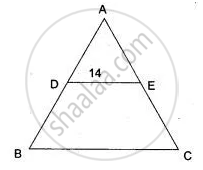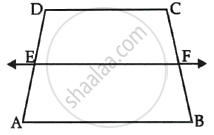Advertisements
Advertisements
प्रश्न
In the adjoining figure. BC is parallel to DE, area of ΔABC = 25 sq cm, area of trapezium BCED = 24 sq cm, DE = 14 cm. Calculate the length of BC.
उत्तर
Given: Area of ΔABC = 25 cm2
Area of trapezium BCED = 24 cm2
and DE = 14 cm
∴ Area of ΔADE = area of ΔABC - area of trap. BCED
= 25 - 24
= 1 cm2
∵ ΔABC ∼ ΔADE
∴ `"Area of (ΔABC)"/"Area of (ΔADE)" = "BC"^2/"DE"^2`
`(25)/(1) = "BC"^2/14^2`
`"BC"/(14) = (5)/(1)`
BC = 5 x 14
= 70 cm.
APPEARS IN
संबंधित प्रश्न
State the SAS-similarity criterion
Are the triangles in the given figure similar? If yes, by which test?

D and E are points on the sides AB and AC respectively of Δ ABC such that AB=5.6cm, AD= 1.4cm, AC=7 .2cm and AE = 1.5 cm, show that DE is parallel to BC
Sides of a triangle are 7, 24 and 25. Determine whether the triangle is a right-angled triangle or not.
Find the area of the triangle ABC with the coordinates of A as (1, −4) and the coordinates of the mid-points of sides AB and AC respectively are (2, −1) and (0, −1).
On a map drawn to scale of 1 : 2,50,000 a rectangular plot of land ABCD has the following measurement AB = 12 cm, BC = 16 cm angles A, B, C, and D are 900 each. Calculate:
(i) The diagonal distance of the plot of land in
(ii) Actual length of diagonal.
In ΔABC, D and E are the mid-point on AB and AC such that DE || BC.
If AD = 8cm, AB = 12cm and AE = 12cm, find CE.
In ΔABC, DE || BC such that AD =1.5 cm, DB = 3 cm and AE = 1 cm. Find AC.
D is the mid point of side BC and AE ⊥ BC. If BC = a, AC = b, AB = c, ED = x, AD = p and AE = h, prove that c2 = `"p"^2 - "a"x + "a"^2/4`
In the given figure, if ABCD is a trapezium in which AB || CD || EF, then prove that `(AE)/(ED) = (BF)/(FC)`.

